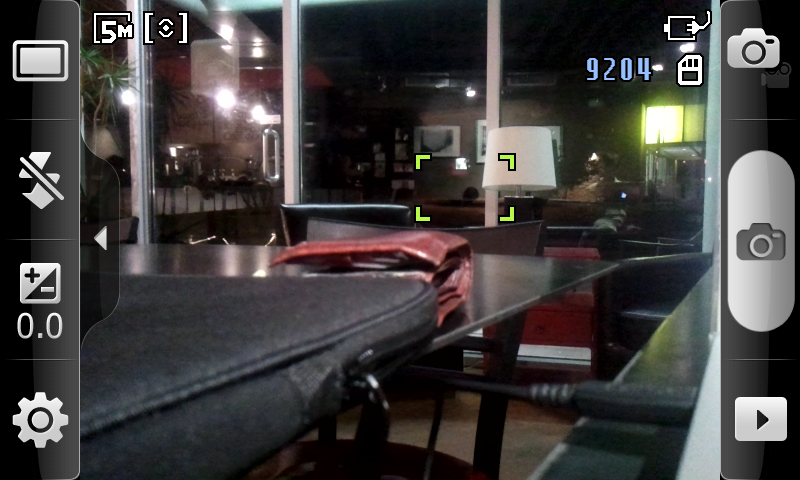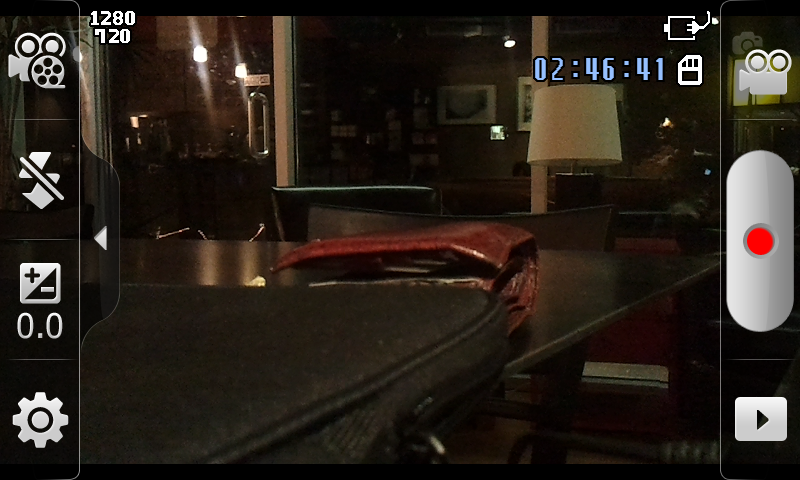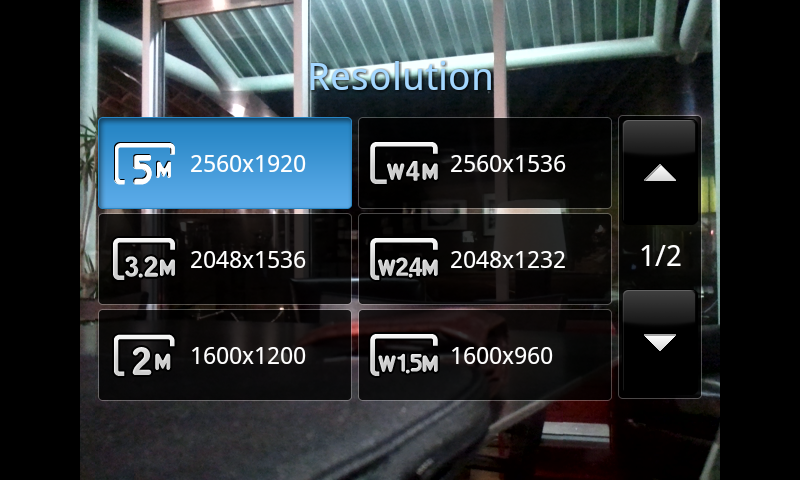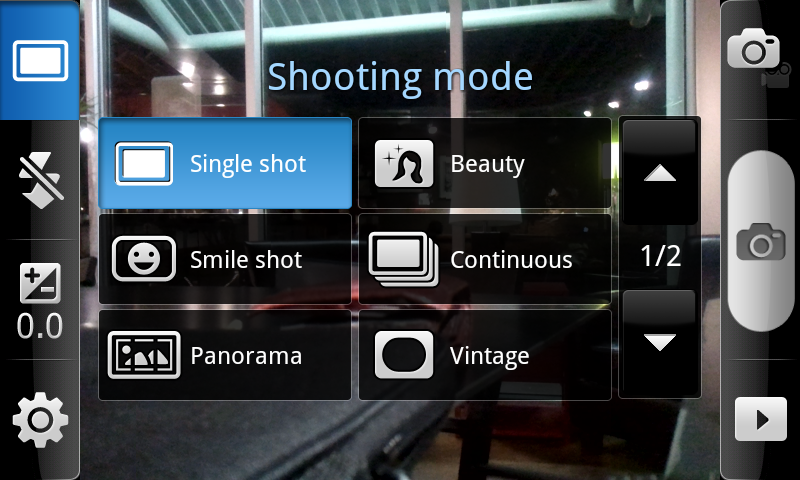Samsung Fascinate Review: Verizon's Galaxy S Smartphone
by Brian Klug on October 5, 2010 12:01 AM EST- Posted in
- Smartphones
- Samsung
- Galaxy S
- Fascinate
- Mobile
Camera
The Fascinate packs a 5 megapixel camera with one LED flash. There's no front facing camera like the Epic 4G, however. Camera launch is relatively speedy, at 2.8 seconds from tapping the application icon to getting a live preview. Successive captures are moderately fast, at around 2 seconds between capture and another preview.
Just like the Epic (and probably the other Galaxy S phones) the camera UI has a simple mode where everything goes away but very basic information and the control buttons. Like Anand said, the camera application repurposes buttons. Power becomes a lock button that stops input, volume controls digital zoom.
Tapping on the left brings up a small drawer with more settings - shooting modes, flash, exposure, and more settings. There's an outdoor visibility button in settings which increases brightness and contrast for composure outside, among all the usual resolution and quality options. Samsung has done a nice job providing lots of control if you want, or abstracting it away if you're inclined.
For a full tour of those settings, check out the gallery below:
Tap to focus is implemented on the Fascinate, including LED illuminated focus when it's dark. There's a confirmation sound when focus is reached as well.
The only nitpick I have about the Fascinate's camera UI is that the icons don't rotate when you switch into portrait mode from landscape. As a result, I was misled many times that images would be recorded rotated 90 degrees. There's rotation support in the captured image's EXIF header for sure, it just doesn't give any feedback in the camera application that acknowledges rotation.
The images captured on the Fascinate are impressive. There's very little distortion or edge falloff, and saturation is about right. There also isn't very much chromatic noise.
The photos taken in the lightbox with the lights on are a bit pink, however detail and dynamic range are quite good. The single LED flash on the Fascinate is actually surprisingly powerful - the photo taken with the lights off is overexposed, which is unfortunate. Apparently the Fascinate doesn't have extremely good short distance metering. This is one case where I wish my lightbox setup was a bit different, since the tradeoff is that photos taken at normal distances are very nicely illuminated. Even better, the camera application focuses with the LED on when you're in the dark, so you have good odds of actually getting focus - something the default Android camera app still doesn't do.
As usual, I've taken photos with the Fascinate in my usual bench locations, and in the lightbox. I've updated things a bit as well with new shots from the Nexus One. A number of readers pointed out that my Nexus One seems to have below average camera performance. I'm inclined to agree that performance seemed below average, and tried numerous times to improve it. I finally got HTC to replace my Nexus One, and reshot everything again, including the video tests. I'd say that the camera performance is largely unchanged between my replacement Nexus One and the old one - the Nexus One camera just isn't as impressive as other 5 MP cameras.
Video on the Fascinate is 720P in H.264 with AAC audio. I measured an average bitrate of 11.89 megabits/s in our bench video at the usual location. Quality is decent but it seems like there's a bit of edge blur and loss of high spatial frequency possibly due to noise reduction. Luckily, you can shoot video with the Fascinate's bright LED flash enabled in the dark. As per usual, compare for yourself with the videos below:
Samsung Fascinate
Motorola Droid 2
BlackBerry Torch 9800
Motorola Droid X
HTC EVO 4G
Nexus One (redux)
iPhone 4
HTC Droid Incredible
Motorola Droid
Nokia N900






































73 Comments
View All Comments
Brian Klug - Tuesday, October 5, 2010 - link
Chemist1,I actually completely agree with you, 100%. When I joined on to tackle smartphones, my big objective has and still is to nail down testing for everything that's traditionally been subjective - battery life, screen quality, performance, signal strength, e.t.c, and make it just as objective as hardware reviews. Of course, audio (voice) quality is on that list as well.
I've been grappling for some time on an ideal test methodology, one that would give a much better (objective) means of testing actual call quality than - it sounded good. I honestly couldn't agree more that this level of analysis is lacking. Unfortunately, until I've got that nailed down, it's really all I can say. What shape that takes is still up in the air.
I've thought of recording the local ASOS weather station test call (which is so far what I use for measuring speakerphone volume) through both the line-out and speaker, then letting people compare those audio files directly. I've considered using some spectral analysis tools similar to determine the pass bandwidth of these phones (of course this would require some tweaking due to cellular latency and also a land line), and a few other things. If you or other commenters have suggestions, I'm more than all ears, seriously ;)
I've actually done a fair amount of playing with CDMA voice codecs in the past - a number of WinMo devices would let you change from relatively-basic EVRC to better 13k voice codecs and a number of others. That kind of discussion and reporting about what codecs each device are using is where I'd like to go, getting that from Android sometimes is very difficult unfortunately. In fact, only device I've really seen that on so far is the EVO. I'd also like to eventually be able to characterize the difference between 1x voice, GSM and UMTS.
There's a lot more we're trying to add for certain, I/we just have to figure out what the best way of testing those would be.
-Brian
jasperjones - Tuesday, October 5, 2010 - link
You may find this shocking but I highly doubt people will consider audio quality as important as you do when deciding for a smartphone.I faintly remember some study on what consumers are looking for in portable audio/MP3 players. Audio quality was NOT in people's top 5! Design, storage capacity, and three other things I cannot recall right now were more important to them. In an audio device!!
So there you go.
chemist1 - Tuesday, October 5, 2010 - link
jasperjones: Thanks for your comment. Well, one needs to be careful of these surveys, since small differences in wording can significantly change the outcome. But your point is well-taken: audio quality is not a top priority for consumers. Nevertheless, that's not to say that audio quality is of no interest to the majority of consumers, nor that it should not therefore be of significant interest to us. [Please see paragraphs 2 and 3 of my reply to kmmanety.]MacTheSpoon - Wednesday, October 6, 2010 - link
Audio quality matters to me, too, thanks for fighting the good fight, chemist1. ;)By the way, I own the phone and I have found the audio to be pretty good for calls so far. At least, I haven't found myself wishing the phone was louder or had any problems distinguishing speech.
Listening to music with headphones...I don't have golden ears, and I don't know how it stacks up to a top mp3 player like a Cowon, but it's definitely not a low-end sound like my iPod Nano 4th Gen or my 2007 Macbook Pro, anyway.
strikeback03 - Thursday, October 7, 2010 - link
Kinda like how in CNET reviews of point and shoot cameras image quality only accounts for something like 10% of their final score.Though a lot of consumers probably just assume audio quality is good enough. The majority are going to put compressed music on there anyway and then use cheap earbuds, so a lot of the audio quality discussion that goes on on tech sites is utterly irrelevant to the majority.
cwebersd - Wednesday, October 6, 2010 - link
In addition to measurements of sound quality, how about a simple internal poll? Record sound samples of various phones, post them with obfuscated names for other staff members to listen to and have them judge intelligibility, clarity, harshness, etc. This should give you a decent sampling of real people's observations. Better than just your own.dagamer34 - Tuesday, October 5, 2010 - link
Brian, there are some JPEG artifacts in your gallery shots. I doubt the D80 has such visible artifacts on a downrezzed shot.Brian Klug - Tuesday, October 5, 2010 - link
Yeah unfortunately the gallery preview images are compressed even though I upload originals from all the cameras. If you click "View original size" you'll get the raw untampered JPEG though, complete with all the EXIF headers and everything you'd get from the camera. Unfortunately I can't control how the engine compresses those images for the gallery preview.-Brian
kmmatney - Tuesday, October 5, 2010 - link
One problem is that the Audio quality changes so much with various factors (signal quality, the phone at the other end, etc..).I would disagree that that the main purpose of these phones is to actually be a "phone". No one cares that much about call quality when they are buying these phones - you just assume it will be acceptable.
softdrinkviking - Tuesday, October 5, 2010 - link
Brian, even though there are many factors, I think you can do an, "all things being equal" type of test with a couple of variations.The data will still be meaningful when you are comparing it to other specific phones.